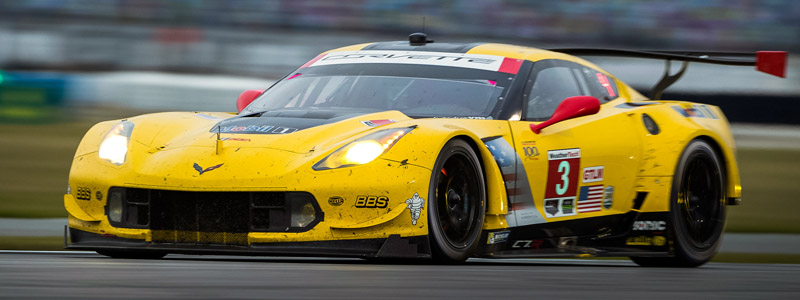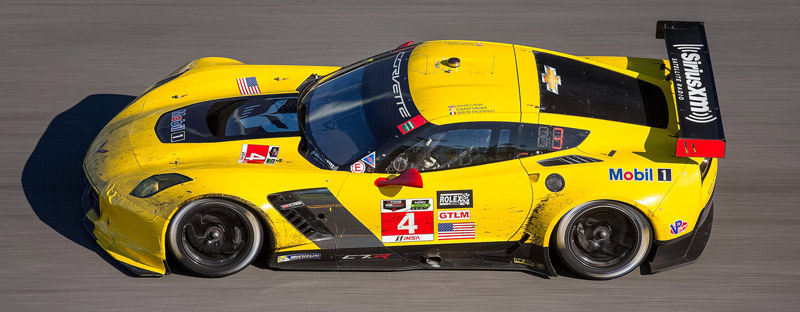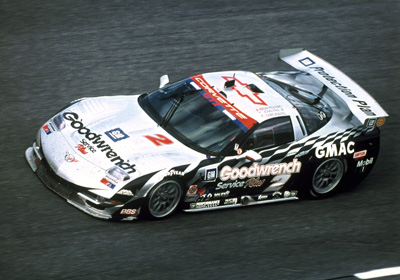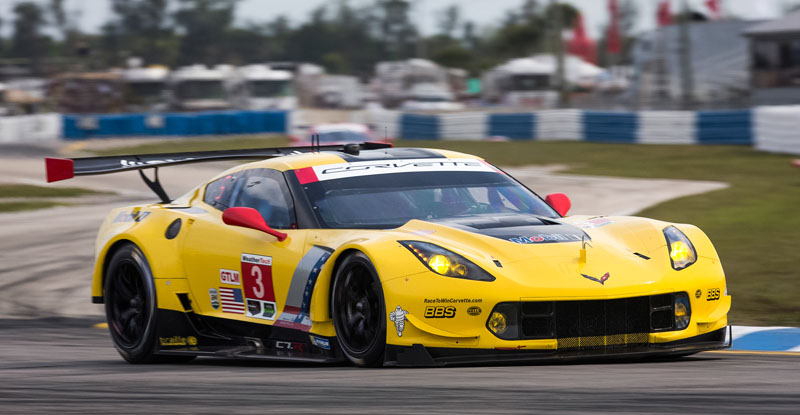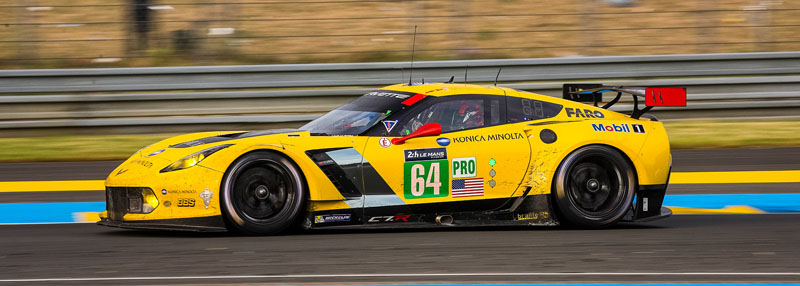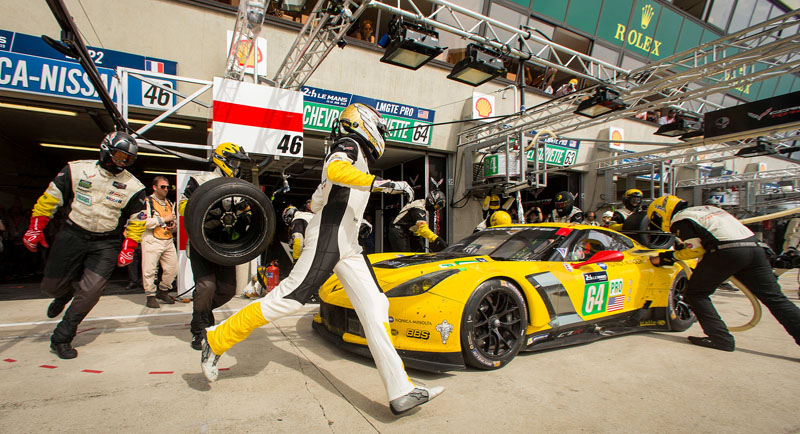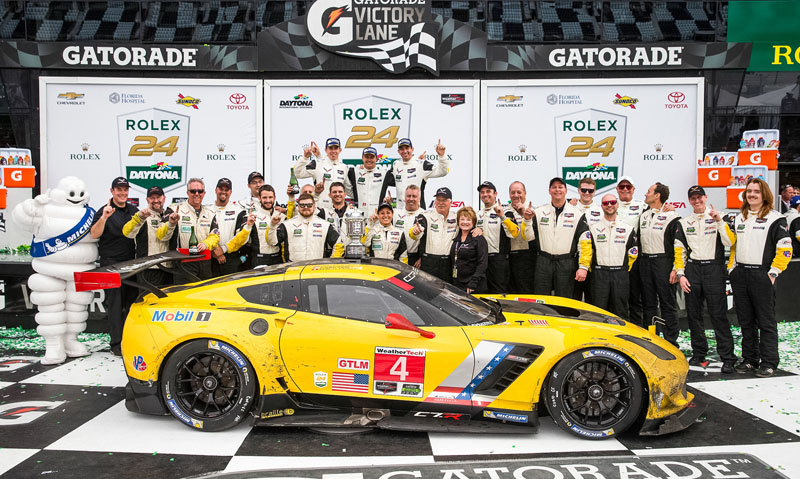Chevrolet Corvette Stingray ZO6 and C7R ( 2015-nowadays )
DETROIT, January 2014 – Chevrolet introduced the 2015 Corvette Z06 at the 2014 NAIAS Detroit Motor Show together with its racing version C7R. The Chevrolet Corvette ZO6 stretches the performance envelope for Corvette with unprecedented levels of aerodynamic downforce, at least 625 horsepower from an all-new supercharged engine, and an all-new, high-performance eight-speed automatic transmission – all building on the advanced driver technologies introduced on the Corvette Stingray. “The new Z06 delivers levels of performance, technology and design that rival the most exotic supercars in the world,” said Mark Reuss, president, General Motors North America. “And the Z06 leverages the engineering expertise of GM, offering the choice of two world-class transmissions, supercar performance without supercar fuel consumption and technologies that make it easier to fully enjoy the incredible experience of driving it.” The 2015 model is the first Corvette Z06 to offer a supercharged engine, an automatic transmission and, thanks to a stronger aluminum frame, a removable roof panel. The new, supercharged 6.2L engine is expected to deliver at least 625 horsepower (466 kW), and can be matched with either a seven-speed manual or an all-new, high-performance eight-speed automatic transmission with paddle shifters for manual control. The aluminum frame carries over from the Corvette Stingray and will be used essentially unchanged for the Corvette Racing C7.R. A track-focused Z07 Performance Package adds unique components for true aerodynamic downforce, Michelin Pilot Super Sport Cup tires for enhanced grip, and Brembo carbon ceramic-matrix brake rotors that improve braking performance and contribute to greater handling through reduced unsprung weight. Although development testing is ongoing, the Z07 package has already recorded some of the fastest lap times ever for a Corvette, surpassing even the ZR1. “The Corvette Z06 is a great example of the technology transfer between racing and production Corvettes,” said Tadge Juechter, Corvette chief engineer. “First, we took what we learned on the Corvette Racing C6.R and applied that to the all-new Corvette Stingray. Then, using the Stingray as a foundation, the Z06 and C7.R were developed to push the envelope of performance on the street and the track.” Supercharged, efficient performance These technologies – combined with the fuel-efficient multi-speed transmissions, aerodynamic design and lightweight construction – help make the new Z06 surprisingly fuel efficient. To maintain the Z06’s mass and performance targets, the LT4 engine was designed with a more-efficient, more-compact supercharger. Even with its integrated supercharger/intercooler assembly mounted in the valley between the cylinder heads, the engine is only about one inch (25 mm) taller than the Corvette Stingray’s LT1 engine – while delivering nearly 37 percent more horsepower and 40 percent more torque.
Eight speeds, no waiting “Unlike most ultra-performance cars, the Corvette Z06 offers customers the choice between two transmissions to suit their driving styles,” said Juechter. “The seven-speed gives the driver the control of a true three-pedal manual transmission with perfect shifts enabled by Active Rev Matching. The new eight-speed automatic offers drivers the comfort and drivability of a true automatic transmission, as well as lightning-fast shifts and manual control for track driving.” The eight-speed automatic is tuned for world-class shift-response times, and smaller steps between gears keep the LT4 within the sweet spot of the rpm band, making the most of the output of the supercharged engine for exhilarating performance and greater efficiency. For performance driving, the transmission offers full manual control via steering wheel paddles, and unique algorithms to deliver shift performance that rivals the dual-clutch/semi-automatic transmissions found in many supercars – but with the smoothness and refinement that comes with a conventional automatic fitted with a torque converter. In fact, the 8L90’s controller analyzes and executes commands 160 times per second, and wide-open throttle upshifts are executed up to eight-hundredths of a second quicker than those of the dual-clutch transmission offered in the Porsche 911. “There’s no trade-off in drivability with the new 8L90 eight-speed automatic transmission – it was designed to deliver performance on par with dual-clutch designs, but without sacrificing refinement,” said Bill Goodrich, assistant chief engineer for eight-speed automatic transmissions. “It is also the highest-capacity automatic transmission ever offered in a Chevrolet car.” Featuring four gearsets and five clutches, creative packaging enables the GM-developed eight-speed automatic to fit the same space as the six-speed automatic used in the Corvette Stingray. Extensive use of aluminum and magnesium make it more than eight pounds (4 kg) lighter than the six-speed. Along with design features that reduce friction, the 8L90 is expected to contribute up to 5-percent greater efficiency, when compared with a six-speed automatic. The eight-speed automatic will be built at GM’s Toledo, Ohio, transmission facility. Designed for downforce “Practically every exterior change served a functional purpose, as this beast needed more of everything,” said Tom Peters, Corvette design director, “The flared fenders accommodate larger, wider wheels and tires for more grip. The larger vents provide more cooling air to the engine, brakes, transmission and differential for increased track capability. The more aggressive aerodynamic package generates true downforce for more cornering grip and high-speed stability.” The design changes began not with the exterior panels, but the tires. To deliver the levels of grip needed for the Z06’s performance targets, the Z06 was fitted with larger Michelin tires (Pilot Super Sport tires for the Z06; Sport Cup 2 tires with the Z07 package). The P285/30ZR19 front tires are 1.5 inches wider than the tires on the Stingray, while the 335/25ZR20 rear tires are two inches wider. To cover the wider tire tread, the fenders of the Z06 were extended by 2.2 inches (56 mm) at the front, and 3.15 inches (80 mm) at the rear. These extensions give the Corvette Z06 a wider, lower appearance further emphasized by a unique rear fascia. It incorporates the same taillamp assemblies as the Stingray, but on the Z06 the taillamps are pushed approximately three inches farther apart, toward to edges of the body. The tires are mounted on lightweight, spin-cast aluminum wheels that are also wider than the Stingray (19 x 10 inches in front and 20 x 12 inches in the rear). Their open, ultralight design showcases the massive Brembo brakes, which are part of the design aesthetic:
To harness the cornering and braking grip afforded by the larger tires and brakes, the exterior of the Corvette Z06 is tailored to produce aerodynamic downforce that presses the tires to the ground at high speeds. The Z06 will offer three, increasing levels of aerodynamic downforce:
The exterior design also reflects the increased cooling required for the new Corvette Z06. For example, the mesh pattern on the front fascia was painstakingly designed to deliver the most possible airflow to the supercharger’s intercooler heat exchanger, so much that the mesh grill directs more air into the engine bay than if the grille was removed. The unique grille also features dedicated brake-cooling intakes and wider grille outlets on the bottom serve as air diffusers. The grille is complemented with a larger hood vent, which vents hot air from the engine compartment and contributes to downforce by allowing air driven through the grille to exit through the hood rather than being forced under the car, which could create lift. Additional cooling elements include larger front fender vents and unique air blades over the inlets on the rear fenders, which force about 50 percent more air into the cooling ducts for the transmission and differential coolers than those on the Stingray. To cope with the additional airflow, the Z06 has also has larger rear-fascia openings than the Stingray. Standard front and rear brake-cooling ducts, including Z06-signature rear ducts integrated in front of the rear fender openings, are also part of the functional design changes. Like the Stingray, the Z06 will be offered with two seating choices: a GT seat, for all-around comfort, and a Competition Sport seat with more aggressive side bolstering, which provides greater support on the track. The frame structure for both seats is made of magnesium, for greater strength and less weight than comparable steel frames. They’re also more rigid, contributing to the enhanced feeling of support during performance driving. The Z06 also benefits from interior details designed for high-performance driving, first introduced on the Stingray, including a steel-reinforced grab bar on the center console for the passenger and soft-touch materials on the edge of the console, where the driver naturally braces during high-load cornering. The performance-supporting elements inside the new Corvette Z06 are complemented by unprecedented attention to detail and build quality. All models feature a fully wrapped interior, where every surface is covered with premium, soft-touch materials. Available materials, depending on the trim level, include Napa leather, aluminum, carbon fiber and micro-suede. Track-proven technologies “Our mission with the seventh-generation Corvette was to make the performance levels more accessible, enabling drivers to exploit every pound-foot of torque, every “g” of grip and every pound of downforce,” said Juechter. “It’s a philosophy we introduced with the 460-horsepower Corvette Stingray – and one that’s even more relevant with an estimated 625 horsepower at your beck and call.” For the first time ever, the Corvette Z06’s aluminum frame will be produced in-house at General Motors’ Bowling Green assembly plant. It’s the same robust, lightweight frame used on the Corvette Stingray and it will be used essentially unchanged for the C7.R race cars. The stiffer design of the aluminum frame allows the Corvette Z06 to be offered with a removable roof panel for the first time. With the lightweight, carbon fiber roof panel removed, the new Corvette Z06 offers 20 percent more structural rigidity than the previous model’s fixed-roof design. It is 60 percent stiffer than the previous model with the roof panel installed. The new Z06 retains the SLA-type front and rear suspension design of the Corvette Stingray but uniquely calibrated for the higher performance threshold. The third-generation Magnetic Selective Ride Control dampers are standard on Z06. They can be adjusted for touring comfort or maximum track performance via the standard Driver Mode Selector. Like the Stingray, the Driver Mode Selector tailors up to a dozen features of the Z06 to suit the driver’s environment, including:
The smart electronic limited-slip differential, or eLSD, is standard on the Z06 to make the most of the torque split between the rear wheels. The system features a hydraulically actuated clutch that can infinitely vary clutch engagement and can respond from open to full engagement in tenths of a second. It shifts torque based on a unique algorithm that factors in vehicle speed, steering input and throttle position to improve steering feel, handling balance and traction. The eLSD is fully integrated with Electronic Stability Control and Performance Traction Management systems. Its calibrations vary among three modes, based on the Drive Mode Selector setting:
The new Corvette Z06 will be available in early 2015. Performance data and pricing will be announced closer to the start of production. Chevrolet Corvette C7R 2015 “When it comes to endurance racing, Corvette has been the benchmark of success for nearly 15 years,” said Jim Campbell, U.S. vice president, Performance Vehicles and Motorsports. “A great deal of the team’s success can be attributed to the symbiotic relationship between Corvette Racing and the production vehicles. The 2015 Corvette Z06 and new C7.R will be more competitive on the street and track due to successful design of the Corvette Stingray – which itself is heavily based on the C6.R race car.” Corvette Racing will field two C7.R race cars in 2014, starting later this month at the 52nd Rolex 24 At Daytona on Jan. 25-26. The race kicks off the TUDOR United SportsCar Championship – a new series debuting this year after the merger of the American Le Mans Series and GRAND-AM Rolex Sports Car Series. The C7.R will compete in the GT Le Mans class in 11 races around North America. The team is also is expected to compete in June at the 24 Hours of Le Mans – a race Chevrolet and Corvette Racing have won seven times – in the GTE Pro class. Since the team’s competitive debut in 1999 with the Corvette C5-R, Corvette Racing has earned unmatched success. The C5-R and C6.R led Chevrolet to 90 victories around the world and 10 manufacturer championships in the American Le Mans Series. In 2013, Corvette Racing won five races and swept the manufacturer, team and driver championships in the GT class for a second consecutive season. A key part of the team’s success is the technology transfer between Corvette production cars and race cars. “Corvette Racing sets the gold standard for technology transfer between the track and street,” said Tadge Juechter, Corvette chief engineer. “We are continually taking what we learn in competition, and applying it to improve production Corvettes – which then make better race cars. As a result, the new Corvette Z06 is the most track-capable production Corvette ever while the new C7.R is poised to be even more competitive on the race circuit.” Many of the architectural and aerodynamic features of the C7.R are based on equivalent components and technologies from the 2015 Corvette Z06, including: New, aluminum frame By leveraging advanced manufacturing materials – such as laser welding, Flowdrill-machined fasteners and a GM-patented aluminum spot-welding process – the production structure is significantly stronger than its predecessor. For Corvette Racing, this equates to a race chassis for the C7.R that is 40 percent stronger than the outgoing C6.R. “In the first lap in the C7.R, the drivers felt the increase in chassis stiffness,” said Mark Kent, director of Racing for Chevrolet. “The drivers instantly noticed that the C7.R handling was better over changing surface features and rough track segments. This is important as our drivers don’t always stay on the smooth pavement, and are constantly driving over curbing at corner apexes.” Direct-injected engine “Direct injection offers two advantages for the race team,” said Kent. “First, it offers drivers more precise throttle control, so that even the smallest changes in the driver’s throttle position delivers a proportional response from the engine. Second, direct injection typically improves fuel economy about 3 percent. That could be enough to bypass one fuel stop during a 24-hour race. Given that races are often won and lost in the pits, a 3 percent gain in fuel economy could translate to a significant advantage in track position.” Aerodynamics The Z06 and C7.R take that aerodynamic foundation to the next level, sharing aggressive strategies for increased cooling and aerodynamic downforce, including similar front splitters, rocker panels, and front- and rear-brake cooling ducts. “We worked concurrently with the race team developing the aerodynamic packages for the Z06 and the C7.R,” said Juechter. “We even used the same modeling software to test both cars, enabling us to share data and wind-tunnel test results. As a result, the aerodynamics of the production Z06 produce the most downforce of any production car GM has ever tested, and we are closing in on the aero performance of a dedicated race car.” There are, of course, differences between the race car and production Corvette Z06. For example, the C7.R carries over the powertrain for the C6.R, as the GT rules limit the maximum displacement to 5.5L, and prohibit forced induction. By comparison, the new Z06 boasts a supercharged 6.2L engine estimated at 625 horsepower. Both engines, however, are based on the historic small block architecture. The suspension on the C7.R is modified to accommodate wider racing tires and larger brakes, again part of the GT regulations. On the aerodynamic side, one major difference is the shift away from U.S. National Advisory Committee for Aeronautics, or NACA, ducts on the C7.R. The C6.R used two NACA ducts, on top of the rear bodywork and near the position of the rear wheels, for cooling. For the new C7.R, there are now openings on each of the rear quarter panels, above the brake ducts, which will draw air to help cool the race car’s transaxle and differential. Additionally, one of the primary results of the C7.R’s aero detail is making the rear wing a more-significant part of the car’s aero package. A larger radiator inlet has the added benefit of generating smoother airflow over the rear wing and making its use more efficient to the handling and stability of the race car at high speed. Related articles :
Wallpapers of the Chevrolet Corvette Stingray ZO6 and C7R 2015 (click on image to enlarge)
|
||||||||||||||||||||||||||||||||||||||||||||||||||||||||||||||||||||||||||||||||||||||||||
|---|---|---|---|---|---|---|---|---|---|---|---|---|---|---|---|---|---|---|---|---|---|---|---|---|---|---|---|---|---|---|---|---|---|---|---|---|---|---|---|---|---|---|---|---|---|---|---|---|---|---|---|---|---|---|---|---|---|---|---|---|---|---|---|---|---|---|---|---|---|---|---|---|---|---|---|---|---|---|---|---|---|---|---|---|---|---|---|---|---|---|
|
||||||||||||||








